Camping is an exciting adventure that lets me connect with nature. But, safety must always come first. In this guide, I’ll share important tips to keep your camping trip safe and fun. Knowing how to stay safe can make all the difference.
By being prepared, I can enjoy my time outdoors more. The National Park Service shows that many accidents could be prevented. This is by following simple safety rules.
Key Takeaways
- Preparation is vital for a successful camping trip.
- Researching your campsite helps identify potential hazards.
- Packing the right gear is crucial for safety.
- Be aware of weather conditions to avoid dangers.
- Understanding wildlife can help you stay safe.
- Use fire safely and responsibly.
- Know how to respond to emergencies effectively.
Understanding Basic Camping Safety
Camping is fun, but you need to know the basics of safety. Knowing what dangers are out there is key. Weather and terrain can be tricky, so it’s good to be ready.
Always carry a first aid kit and learn basic first aid. This way, you’re ready for anything.
The American Camping Association says having a safety mindset is crucial. It keeps you alert and ready to act. Remember, knowing your limits is important. This means knowing how far you can go physically and with outdoor skills.
Being aware helps you take the right steps to stay safe. This way, you’re ready for anything that comes your way.
| Safety Concept | Description | Importance |
|---|---|---|
| Understanding Hazards | Recognizing potential dangers in the camping area. | Prevents accidents and injuries. |
| Emergency Preparedness | Having a first aid kit and knowing basic first aid. | Enables quick response in emergencies. |
| Limit Awareness | Knowing my physical and skill limitations. | Ensures I do not overexert myself. |
| Safety Mindset | Staying vigilant and proactive about safety. | Encourages a culture of safety. |
Essential Camping Safety Tips for Beginners
Getting ready for a camping trip is key to a great experience. Knowing the campsite’s layout and rules is important. It helps me plan better and stay safe.
Preparation is Key
Packing right is crucial for a fun camping trip. Here are some safety tips:
- Make a checklist of essential items.
- Invest in high-quality gear suited for my environment.
- Test equipment at home before my trip.
Knowing the campsite’s limits and planning activities that fit my level keeps things fun and safe.
Research Your Campsite
Understanding the terrain and access to important resources is vital. Knowing the local weather helps avoid surprises. The Forest Service offers tools to check campsite conditions and safety needs. Here’s a quick guide:
| Aspect | Tips |
|---|---|
| Campsite Layout | Learn about location facilities, including restrooms and water sources. |
| Weather Conditions | Use forecasts to pack appropriate clothing and gear. |
| Terrain Type | Identify landmarks to assist with navigation and safety. |
Packing the Right Gear
Keeping safe while camping starts with the right gear. The right stuff makes my trip better and keeps me safe in emergencies. It’s all about picking items that keep me safe, especially in new places.
Must-Have Safety Equipment
For a camping trip, I focus on key safety gear. Here’s what I always bring:
- First Aid Kit: A good first aid kit helps with small injuries.
- Flashlights: Flashlights with extra batteries are key for nighttime safety.
- Emergency Blankets: These are light and keep warm, crucial in cold weather.
- Multi-Tool: A multi-tool is handy for many tasks.
- Whistles: Whistles are great for calling for help in emergencies.
Choosing the Right Tent
The tent I choose is very important for safety. Different tents are made for different weather and conditions. I look at a few things when picking:
- Weather Resistance: A tent that matches the season keeps me dry.
- Size and Weight: The right size is comfy, and a light tent is easier to carry.
- Durability: Good materials mean my tent lasts longer and is more reliable.
- Setup: An easy-to-set-up tent saves time and keeps me safe.
Following safety tips when choosing gear makes my camping trips safe and fun. With the right gear, I’m ready for anything.
Understanding Weather Conditions
Knowing the weather is key to staying safe outside. Before I go camping, I always check the local forecast. I use weather apps or portable radios to stay informed about any changes.
Severe storms or sudden cold can really impact my trip. They can pose serious risks.
Understanding weather patterns helps me make smart choices. If the weather changes, I can quickly find shelter or move my camp. It’s smart to camp away from dangers like floods or steep cliffs.
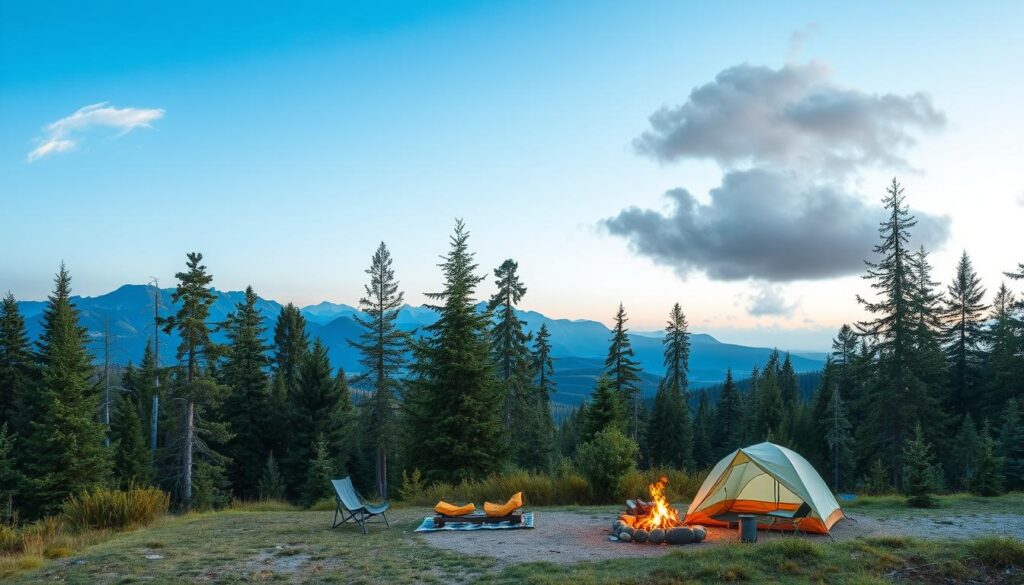
Being alert to the weather helps me stay safe and enjoy nature. Being prepared and aware is crucial for a safe outdoor adventure.
Wildlife Awareness and Precautions
Knowing about local wildlife is key for safe camping. It’s important to keep food safe and know about dangerous animals. This helps avoid bad experiences on your trip. Here are some important tips for beginners.
Keeping Food Secure
Keeping food safe is crucial when camping. It keeps animals away and makes the area safer. Animals, especially bears, are drawn to food smells. Here are some tips:
- Use bear-resistant containers for food and scented items.
- Hang food 10 feet off the ground and 4 feet from tree trunks.
- Never leave food in your tent or around the campsite.
Recognizing Dangerous Animals
It’s important to know about local wildlife for safety. Different places have different animals, some of which are dangerous. Here are some animals to watch out for and how to stay safe:
| Animal | Danger Level | Precautions |
|---|---|---|
| Bears | High | Make noise to avoid surprising them; store food securely. |
| Snakes | Medium | Stay on trails; wear boots and watch where I step. |
| Mountain Lions | High | Stay calm if encountered; maintain eye contact and back away slowly. |
Knowing the risks of each animal is important. Learning about local animals from places like the National Wildlife Federation helps. This way, I can enjoy camping safely.
Campsite Safety Etiquette
Being respectful to others is key to a safe campsite. I keep my voice down, especially at night. This helps everyone enjoy the outdoors more.
Keeping the campsite clean is also important. I throw away trash properly. This keeps the area beautiful and safe from wildlife.
It’s vital to know where to cook and have fires. I follow the signs to avoid accidents. Using fires safely is a must.
Talking with fellow campers helps everyone stay safe. In groups, we share plans and watch out for each other. This way, we all stay safe while camping.
- Respect others’ personal space.
- Clean up after meals and campfires.
- Keep a travel flashlight or headlamp available for nighttime use.
- Notify others before leaving the campsite.
| Etiquette Practice | Benefits |
|---|---|
| Maintain low noise levels | Creates a peaceful atmosphere |
| Proper waste disposal | Protects nature and wildlife |
| Use designated cooking areas | Reduces fire hazards |
| Effective communication | Enhances group safety |
Fire Safety and Guidelines
Fire safety is crucial when I go camping. It’s part of my guide to camping safety. I need to know how to handle firewood and manage my campfire well. Keeping the area around the fire safe is key to avoiding accidents and protecting nature.
Choosing the Right Firewood
Choosing the right firewood is my first priority. Not all wood burns well or safely. Here are some tips:
- Choose seasoned hardwood for a longer burn and less smoke.
- Avoid wood from the ground at the campsite, as it may have insects.
- Use dry, split logs for easier ignition and a cleaner burn.
Extinguishing Your Fire Properly
Knowing how to put out my fire is just as important. Before leaving, I make sure the fire is fully extinguished to prevent wildfires. Here’s how to do it right:
- Let the fire burn down to ashes if possible.
- Spread the ashes out to cool them faster.
- Pour water on the ashes slowly while stirring with a stick to soak everything well.
- Make sure everything is cool to the touch before leaving.
Learning about fire safety makes my camping trips better. By following these tips, I help make camping safer for everyone. Knowing the U.S. Forest Service’s fire safety rules helps me camp responsibly.
Staying Hydrated and Healthy
As I start my camping trips, keeping hydrated is key. It’s not just about having the right gear. It’s also about keeping my body working well. Having clean water is crucial, so I look into different ways to purify it.
Water Purification Methods
Here are some ways I make sure my water is safe to drink:
- Boiling: This is simple. Boiling water for a minute kills most germs, making it safe.
- Filtration Systems: Portable water filters are handy. Brands like Sawyer and Katadyn remove bacteria and protozoa well.
- Chemical Treatments: I use iodine or chlorine dioxide tablets. It’s important to follow the instructions, usually waiting 30 minutes before drinking.
- UV Light Purification: UV pens, like SteriPEN, use ultraviolet light to kill germs in water.
Each method has its good and bad sides. I pick what’s best for my camping trip. Choosing good food is also key for staying healthy. I go for non-perishable, high-quality food to avoid getting sick.
| Purification Method | Pros | Cons |
|---|---|---|
| Boiling | Simple and highly effective | Requires fuel or a heat source |
| Filtration | Portable and easy to use | May not remove viruses |
| Chemical Treatments | Effective against bacteria and protozoa | May leave an unpleasant taste |
| UV Light | Fast and effective | Requires batteries to operate |

Thinking about hydration and food choices makes my camping trips safer and more fun. With the right planning, I’m ready to enjoy the outdoors.
Navigating the Outdoors Safely
Effective navigation is key for a great camping trip. Knowing how to read maps and use compasses is vital. It helps me stay safe outdoors. Learning to read topographical maps is essential for spotting elevation changes and trails.
Using Maps and Compasses
Maps and compasses make navigating the wilderness easier. Here are some tips:
- Know the basics: Learn how to read a map and understand symbols.
- Practice compass skills: Mastering the compass helps you navigate unknown areas.
- Plan your route: A good plan keeps you safe and on track.
Staying on Marked Trails
Staying on trails is crucial for safety. Going off trails risks my safety and harms the environment. Here’s why trails are important:
- They protect wildlife and plants.
- They reduce the risk of getting lost.
- They help keep trails good for future hikers.
Modern tech like GPS and apps also helps. But, I know their limits, especially in weak signal areas. Using both old and new methods keeps me safe while enjoying my trip. For more camping safety tips, visit this link.
| Navigation Method | Advantages | Limitations |
|---|---|---|
| Map and Compass | Reliable, does not require power | Requires practice to use effectively |
| GPS Device | User-friendly, provides real-time location | Battery-dependent, may lose signal |
| Mobile App | Typically has additional features, like terrain notes | Signal reliance, drainage of battery life |
Communication During Your Camping Trip
Good communication is key for a safe and fun camping trip. It’s important to make a plan for how to stay in touch with everyone. This way, we can easily find each other if we get separated. It’s a big part of the safety tips I always follow.
When cell phones don’t work, it’s smart to bring extra ways to talk. Walkie-talkies are great for short distances. For really far-off places, satellite phones are a lifesaver. They let us call for help when we need to. It’s crucial that everyone knows how to use these tools.
Here are some tips for staying in touch:
- Designate a meeting point in case anyone gets lost.
- Utilize hand signals or whistles for quick communication.
- Establish regular check-in times to ensure everyone is accounted for.
Following these tips helps keep our camping trips safe and fun. Thinking ahead about how we’ll communicate gives us peace of mind. It makes the whole adventure better.
| Device | Range | Best Use |
|---|---|---|
| Walkie-Talkie | 2-5 miles (varies with terrain) | Short distances within a group |
| Satellite Phone | No range limit (depends on satellite coverage) | Remote areas without cell service |
| Mobile Phone | Dependent on service provider | General communication in populated areas |
Responding to Emergencies
Camping is a rewarding experience, but being prepared for emergencies is crucial. Knowing how to respond effectively ensures a safe trip. Essential camping safety precautions for beginners include having a well-stocked first aid kit and knowing important emergency contacts. These elements can make a significant difference in crisis situations.
First Aid Kit Essentials
A comprehensive first aid kit is a must-have for any camping adventure. Here are the key items I recommend including:
- Adhesive bandages in various sizes for cuts and scrapes
- Gauze pads and adhesive tape for larger wounds
- Antiseptic wipes or spray to clean injuries
- Pain relievers like ibuprofen or acetaminophen
- Allergy medication for unexpected reactions
- Burn cream for minor burns
- Instant cold packs to reduce swelling
- Scissors and tweezers for removal of splinters or cutting bandages
Knowing Emergency Contacts
Knowing who to contact in an emergency can expedite help. Before I head out, I make sure to establish a list of important contacts, including:
- Local park rangers or campground management for assistance
- Emergency services numbers, such as 911 in the United States
- Family or friends who are aware of my camping location and itinerary
I have found that combining a well-prepared first aid kit with emergency contact knowledge greatly enhances camping safety. Being informed and ready empowers me to handle unexpected situations confidently.
Conclusion
As I finish this guide to camping safety, I see how important it is to be ready for outdoor adventures. Following key safety tips makes camping better and more fun. It also makes new campers feel more confident.
Choosing the right gear, knowing the weather, and watching out for wildlife are all important. These steps help make sure your trip is safe and fun.
It’s also vital to talk to your group, stay alert, and follow safety rules. Having a good first aid kit and knowing emergency numbers is crucial. Safety is a must for camping, not just a suggestion.
I urge new campers to follow these safety tips on their trips. This way, we can all enjoy nature safely. Happy camping, and may your adventures be exciting and safe!
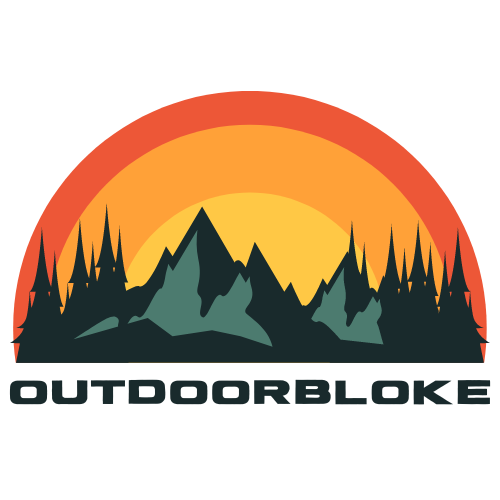
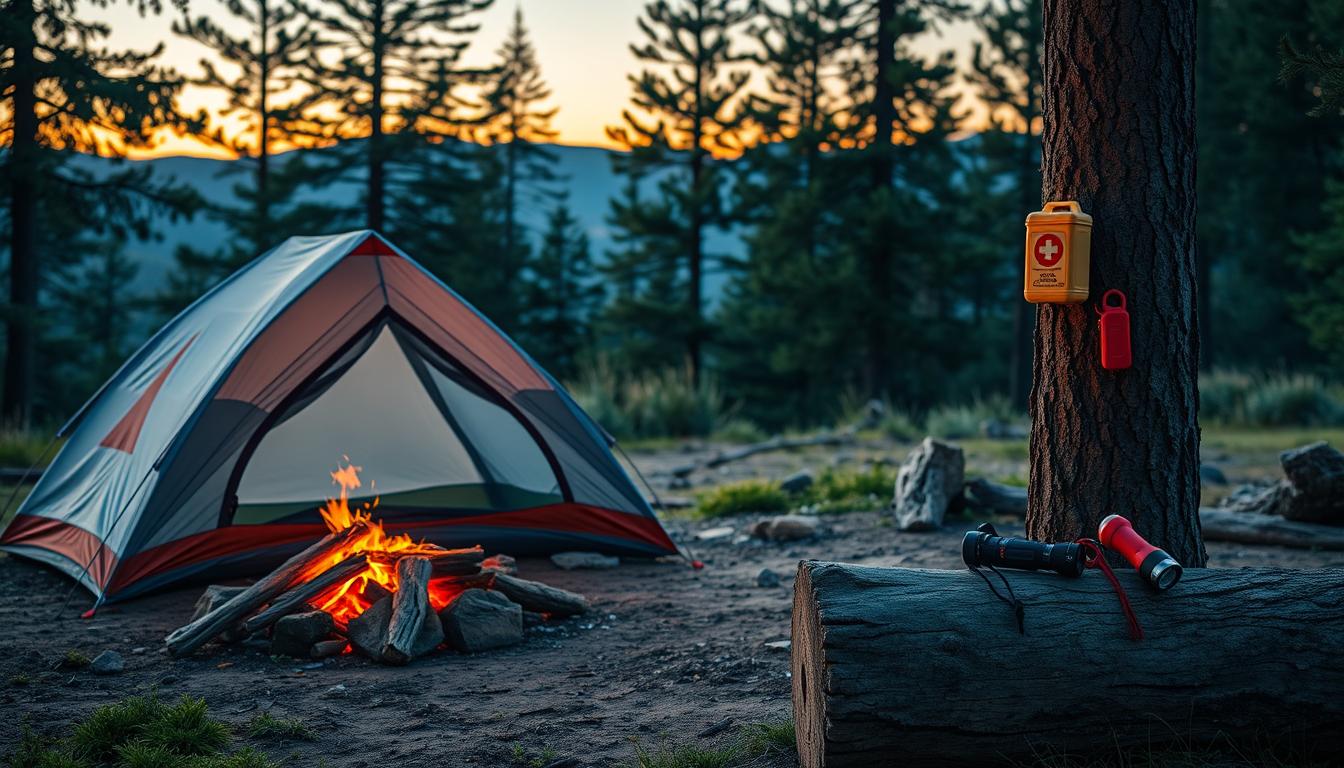

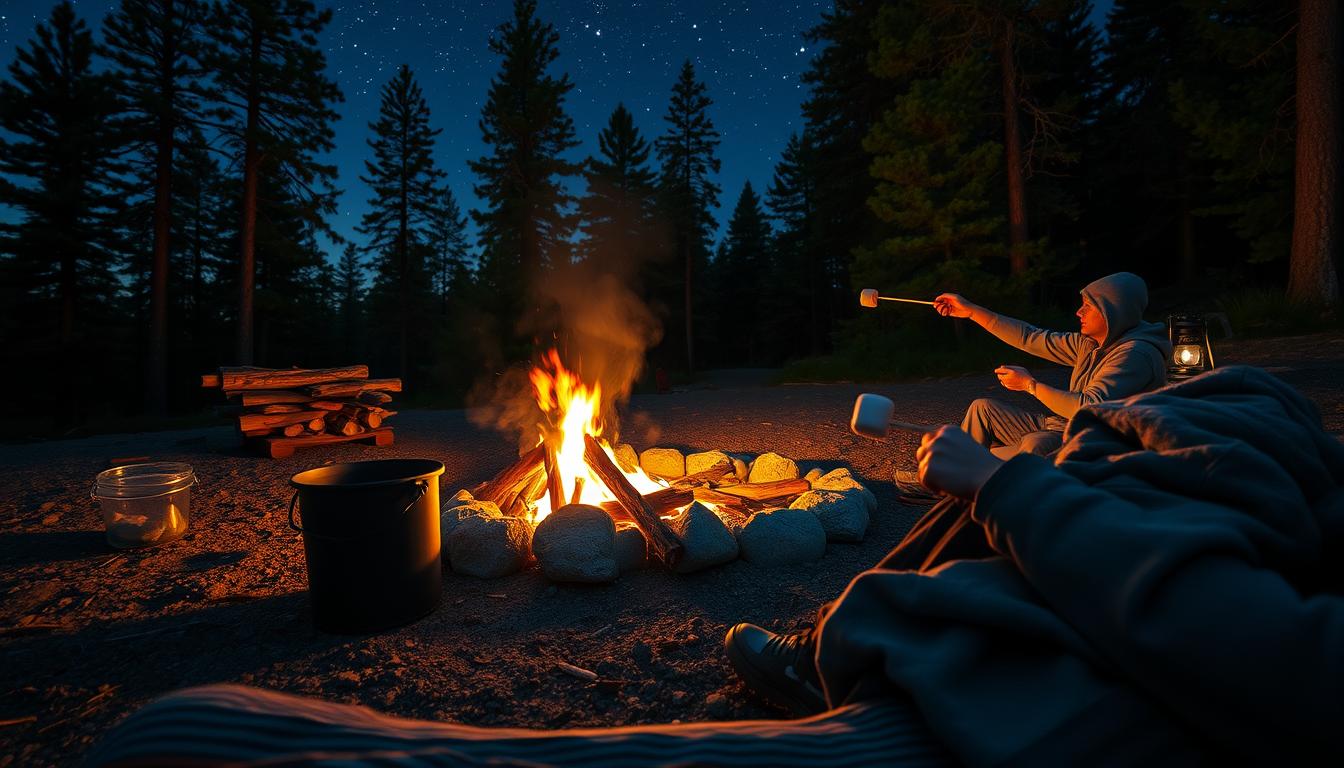
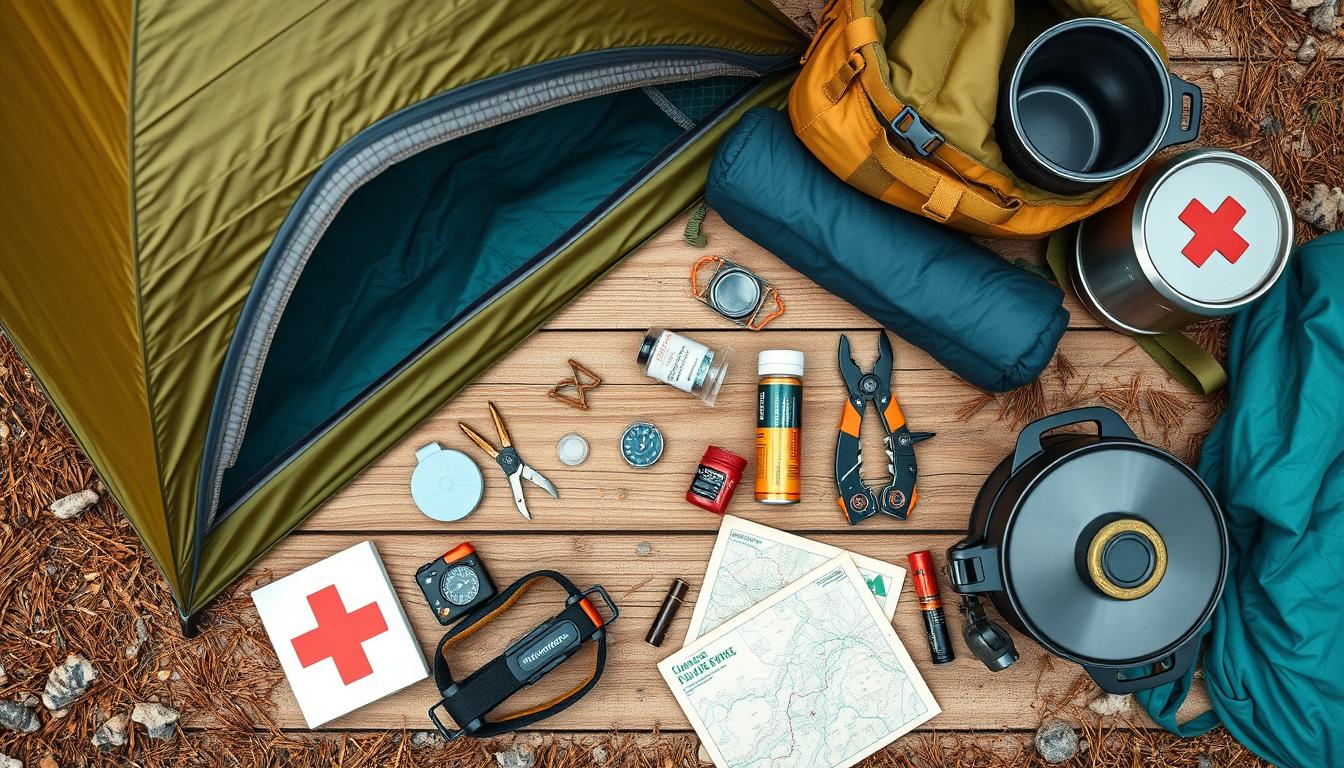
Leave a Reply